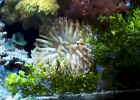 This is a picture is of my Long Tentacle Anemone. It was given to me by my
brother. He had to dismantle his reef for lack of time to perform maintenance.
It lived in his tank for just over a year and has been in mine for approximately
3 months. At first, it roam the tank quite a bit before settling down in the
spot pictured. I feed it a quarter piece of raw shrimp every other night. I hope
this guy lives longer than other anemones I've had in the past. I've nicknamed
myself as the Natural Born Anemone Killer. I vowed to never buy another one
again. I had no choice but to take this one off of my brother hands...he begged
me.
This is a picture is of my Long Tentacle Anemone. It was given to me by my
brother. He had to dismantle his reef for lack of time to perform maintenance.
It lived in his tank for just over a year and has been in mine for approximately
3 months. At first, it roam the tank quite a bit before settling down in the
spot pictured. I feed it a quarter piece of raw shrimp every other night. I hope
this guy lives longer than other anemones I've had in the past. I've nicknamed
myself as the Natural Born Anemone Killer. I vowed to never buy another one
again. I had no choice but to take this one off of my brother hands...he begged
me.
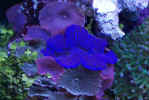 This is a small Tridacna maxima clam. It is about 3" in this
picture. It was about 1" when I bought it 1 1/2 years ago. It seems to be a
slow grower, but I suspect it's growth would be better if it were placed closer
to the surface of the tank. It gets overgrown by nearby Mushroom polyps and I
have to trim them of it's shells once every month or so. In my experience, clams
do not require much attention when water conditions are optimal. They do not
require feedings and do very well under Metal Halide lighting. Water flow should
be set so that the mantle the does not get blown around.
This is a small Tridacna maxima clam. It is about 3" in this
picture. It was about 1" when I bought it 1 1/2 years ago. It seems to be a
slow grower, but I suspect it's growth would be better if it were placed closer
to the surface of the tank. It gets overgrown by nearby Mushroom polyps and I
have to trim them of it's shells once every month or so. In my experience, clams
do not require much attention when water conditions are optimal. They do not
require feedings and do very well under Metal Halide lighting. Water flow should
be set so that the mantle the does not get blown around.
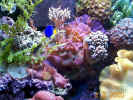 These are various species of Actinodiscus sp. polyps commonly known as
Mushroom polyps. They are a good choice for beginners. They do well under all
lighting conditions, even normal output fluorescent bulbs. Mushrooms will even
thrive under higher nutrient levels. They can be easily propagated and will
multiply rapidly.
These are various species of Actinodiscus sp. polyps commonly known as
Mushroom polyps. They are a good choice for beginners. They do well under all
lighting conditions, even normal output fluorescent bulbs. Mushrooms will even
thrive under higher nutrient levels. They can be easily propagated and will
multiply rapidly.
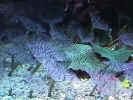 These fans worms have taken over my sand bed. The population originated from two
individual that hitched their way in on a piece of Savaii rock which I placed
near the top of the reef structure. Within a few months, they reproduced and the
colony slowly grew toward the bottom. The colony eventually made it to the sand
bed. The part of the colony that had grown on the live rock slowly disappeared.
These fans worms have taken over my sand bed. The population originated from two
individual that hitched their way in on a piece of Savaii rock which I placed
near the top of the reef structure. Within a few months, they reproduced and the
colony slowly grew toward the bottom. The colony eventually made it to the sand
bed. The part of the colony that had grown on the live rock slowly disappeared.
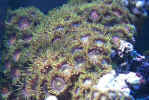 Here is a picture of a colony of various Zoanthid sp. polyps. This rock
was nearly cleaned of these polyps over a few days by a band of small Nudibranchs
that must of hitched their way into my tank. I had no clue why they the polyps
were dying until I found one of the Nudibranchs munching away. I had to remove
the rock out of the tank a pick each nudi off the rock with tweezers. They
quickly recovered after removing the little predators. I don't directly feed the
polyps, but they do capture food that floats by when feeding the fish. Polyps
are very hardy and require little attention which makes them excellent for
beginners.
Here is a picture of a colony of various Zoanthid sp. polyps. This rock
was nearly cleaned of these polyps over a few days by a band of small Nudibranchs
that must of hitched their way into my tank. I had no clue why they the polyps
were dying until I found one of the Nudibranchs munching away. I had to remove
the rock out of the tank a pick each nudi off the rock with tweezers. They
quickly recovered after removing the little predators. I don't directly feed the
polyps, but they do capture food that floats by when feeding the fish. Polyps
are very hardy and require little attention which makes them excellent for
beginners.
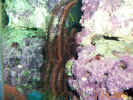 This is a common brown brittle star. I am not sure of the scientific name. My
brother gave it to me after he dismantled his reef tank. This guy is somewhat
reclusive and remains wedged in between rocks until a few hours after the tank
lights go out. I feed him a piece of shrimp now and then. He also scavenges the
reef at night for small left over food and detritus.
This is a common brown brittle star. I am not sure of the scientific name. My
brother gave it to me after he dismantled his reef tank. This guy is somewhat
reclusive and remains wedged in between rocks until a few hours after the tank
lights go out. I feed him a piece of shrimp now and then. He also scavenges the
reef at night for small left over food and detritus.
 This is brittle star, which I have not yet identified, hitched it's way on my
large Rose Leather coral. It was about an inch from the tip of one tentacle to
the other when I first spotted it in the reef. Within about three (3) months it
reached about 6" from tip to tip. It is now about 10" from tip to tip,
full grown I suppose. It is not as aggressive as the other brittle or the
serpent star. The body and tentacle width is much smaller than the others as
well. It feeds mostly on detritus but occasionally gets a piece of shrimp or
scallop.
This is brittle star, which I have not yet identified, hitched it's way on my
large Rose Leather coral. It was about an inch from the tip of one tentacle to
the other when I first spotted it in the reef. Within about three (3) months it
reached about 6" from tip to tip. It is now about 10" from tip to tip,
full grown I suppose. It is not as aggressive as the other brittle or the
serpent star. The body and tentacle width is much smaller than the others as
well. It feeds mostly on detritus but occasionally gets a piece of shrimp or
scallop.
 Ophiarachna incrassata is a very aggressive feeder. He will trample over
corals and other sessile invertebrates to get to a piece of food. He frequently
steals food from the polyps of corals. These starfish are reported to be fish
eaters as well. I observed it trap a small scooter blenny I had with it's
tentacles soon after I placed in it my reef over 2.5 years ago. He did not eat
the fish however, let it go after a few minutes. He has not exhibited any
aggression to any other fish since.
Ophiarachna incrassata is a very aggressive feeder. He will trample over
corals and other sessile invertebrates to get to a piece of food. He frequently
steals food from the polyps of corals. These starfish are reported to be fish
eaters as well. I observed it trap a small scooter blenny I had with it's
tentacles soon after I placed in it my reef over 2.5 years ago. He did not eat
the fish however, let it go after a few minutes. He has not exhibited any
aggression to any other fish since.
This is a cutting from a large photosynthetic Gorgonian at a LFS. This picture
was taken about 2 weeks after propagation. I placed it near the bottom of the
tank where it receives very good water movement. As you can see, display nice
polyp extension in this location. I hope to propagate this Gorgonian once it
grows to a size that it can afford to loose a couple of branches.

![]()